Catacomb, a subterranean excavation for the interment of the dead or burial-vault. In this sense the word “catacomb” has gained universal acceptance, and has found a place in most modern languages. The original term, catacumbae, however, had no connexion with sepulture, but was simply the name of a particular locality in the environs of Rome. It was derived from the Greek κατά and κύμβη, “a hollow,” and had reference to the natural configuration of the ground. In the district that bore this designation, lying close to the Appian Way, the basilica of San Sebastiano was erected, and the extensive burial-vaults beneath that church—in which, according to tradition, the bodies of the apostles St Peter and St Paul rested for a year and seven months previous to their removal to the basilicas which bear their names—were, in very early times, called from it coemeterium ad catacumbas, or catacumbas alone. From the celebrity of this cemetery as an object of pilgrimage its name became extensively known, and in entire forgetfulness of the origin of the word, catacumbae came to be regarded as a generic appellation for all burial-places of the same kind. This extension of the term to Christian burial-vaults generally dates from the 9th century, and obtained gradual currency through the Christian world. The original designation of these places of sepulture is crypta or coemeterium.
The largest number of Christian catacombs belong to the 3rd and the early part of the 4th centuries. The custom of subterranean interment gradually died out, and entirely ceased with the sack of Rome by Alaric, a.d. 410. “The end of the catacomb graves,” writes Mommsen (Cont. Rev., May 1871), “is intimately connected with the end of the powerful city itself.... Poverty took the place of wealth, ... the traditions of the Christian tomb-architects sank into utter insignificance, and the expanse of the wasted Campagna now offered room enough to bury the few bodies, without having to descend as once far down below the surface of the earth.” The earliest account of the catacombs, that of St Jerome narrating his visits to them when a schoolboy at Rome, about a.d. 354, shows that interment in them was even then rare if it had not been altogether discontinued; and the poet Prudentius’s description of the tomb of the Christian martyr Hippolytus, and the cemetery in which it stood, leads us to the same conclusion. With the latter part of the 4th century a new epoch in the history of the catacombs arose—that of religious reverence. In the time of Pope Damasus, a.d. 366-384, the catacombs had begun to be regarded with special devotion, and had become the resort of large bands of pilgrims, for whose guidance catalogues of the chief burial-places and the holy men buried in them were drawn up. Some of these lists are still extant.1 Pope Damasus himself displayed great zeal in adapting the catacombs to their new purpose, restoring the works of art on the walls, and renewing the epitaphs over the graves of the martyrs. In this latter work he employed an engraver named Furius Philocalus, the exquisite beauty of whose characters enables the smallest fragment of his work to be recognized at a glance. This gave rise to extensive alterations in their construction and decoration, which has much lessened their value as authentic memorials of the religious art of the 2nd and 3rd centuries. Subsequent popes manifested equal ardour, with the same damaging results, in the repair and adornment of the catacombs, and many of the paintings covering their walls, which have been assigned to the period of their original construction, are really the work of these later times. The catacombs shared in the devastation of Rome by the Goths under Vitiges in the 6th century and by the Lombards at a later period; and partly through the spoliation of these barbarian invaders, partly through the neglect of those who should have been their guardians, they sank into such a state of decay and pollution that, as the only means of preserving the holy remains they enshrined from further desecration, Pope Paul I., in the latter part of the 8th century, and Pope Paschal, at the beginning of the 9th, entered upon the work of the translation of the relics, which was vigorously carried on by successive pontiffs until the crypts were almost entirely despoiled of their dead. The relics having been removed, the visits of pilgrims naturally ceased, and by degrees the very existence of those wonderful subterranean cemeteries was forgotten. Six centuries elapsed before the accidental discovery of a sepulchral chamber by some labourers digging for pozzolana earth (May 31, 1578) revealed to the amazed inhabitants of Rome “the existence,” to quote a contemporary record, “of other cities concealed beneath their own suburbs.” Baronius, the ecclesiastical historian, was one of the first to visit the new discovery, and his Annals in more than one place evidence his just appreciation of its importance. The true “Columbus of this subterranean world,” as he has been aptly designated, was the indefatigable Antonio Bosio (d. 1629), who devoted his life to the personal investigation of the catacombs, the results of which were given to the world in 1632 in a huge folio, entitled Roma sotterranea, profusely illustrated with rude but faithful plans and engravings. This was republished in a Latin translation with considerable alterations and omissions by Paolo Aringhi in 1651; and a century after its first appearance the plates were reproduced by Giovanni Bottari in 1737, and illustrated with great care and learning. Some additional discoveries were described by Marc Antonio Boldetti in his Osservazioni, published in 1720; but, writing in the interests of the Roman Church with an apologetic, not a scientific object, truth was made to bend to polemics, and little addition to our knowledge of the catacombs is to be gained from his otherwise important work. The French historian of art, Seroux d’Agincourt, 1825, by his copious illustrations, greatly facilitated the study of the architecture of the catacombs and the works of art contained in them. The works of Raoul Rochette display a comprehensive knowledge of the whole subject, extensive reading, and a thorough acquaintance with early Christian art so far as it could be gathered from books, but he was not an original investigator. The great pioneer in the path of independent research, which, with the intelligent use of documentary and historical evidence, has led to so vast an increase in our acquaintance with the Roman Catacombs, was Padre Marchi of the Society of Jesus. His work, Monumenti delle arti christiane primitive, is the first in which the strange misconception, received with unquestioning faith by earlier writers, that the catacombs were exhausted sand-pits adapted by the Christians to the purpose of interment, was dispelled, and the true history of their formation demonstrated. Marchi’s line of investigation was followed by the Commendatore De Rossi, and his brother Michele, the former of whom was Marchi’s fellow-labourer during the latter part of his explorations; and it is to them that we owe the most exhaustive scientific examination of the whole subject. The Catacombs of Rome are the most extensive with which we are acquainted, and, as might be expected in the centre of the Christian world, are in many respects the most remarkable. No others have been so thoroughly examined and illustrated. These may, therefore, be most appropriately selected for description as typical examples.
Our description of the Roman Catacombs cannot be more appropriately introduced than by St Jerome’s account of his visits to them in his youth, already referred to, which, after the lapse of above fifteen centuries, presents a Catacombs of Rome. most accurate picture of these wonderful subterranean labyrinths. “When I was a boy,” he writes, “receiving my education in Rome, I and my schoolfellows used, on Sundays, to make the circuit of the sepulchres of the apostles and martyrs. Many a time did we go down into the catacombs. These are excavated deep in the earth, and contain, on either hand as you enter, the bodies of the dead buried in the wall. It is all so dark there that the language of the prophet (Ps. lv. 15) seems to be fulfilled, ‘Let them go down quick into hell.’ Only occasionally is light let in to mitigate the horror of the gloom, and then not so much through a window as through a hole. You take each step with caution, as, surrounded by deep night, you recall the words of Virgil—
“Horror ubique animos, simul ipsa silentia terrent.”2
In complete agreement with Jerome’s vivid picture the visitor to the Roman Catacombs finds himself in a vast labyrinth of narrow galleries, usually from 3 to 4 ft. in width, interspersed with small chambers, all excavated at successive levels, in the strata of volcanic rock subjacent to the city and its environs, and constructed originally for the interment of the Christian dead. The galleries are not the way of access to the cemeteries, but are themselves the cemeteries, the dead being buried in long low horizontal recesses, excavated in the vertical walls of the passages, rising tier above tier like the berths in a ship, from a few inches above the floor to the springing of the arched ceiling, to the number of five, six or even sometimes twelve ranges. These galleries are not arranged on any definite plan, but, as will be seen from the plan (fig. 1), they intersect one another at different angles, producing an intricate network which it is almost impossible to reduce to any system. They generally run in straight lines, and as a rule preserve the same level. The different storeys of galleries lie one below the other (fig. 2) to the number of four or five (in one part of the cemetery of St Calixtus they reach seven storeys), and communicate with one another by stairs cut out of the living rock. Light and air are introduced by means of vertical shafts (luminaria) running up to the outer air, and often serving for several storeys. The drawing (fig. 3) from Northcote gives a very correct idea of these galleries, with the tiers of graves pierced in the walls. The doorways which are seen interrupting the lines of graves are those of the family sepulchral chambers, or cubicula, of which we shall speak more particularly hereafter.
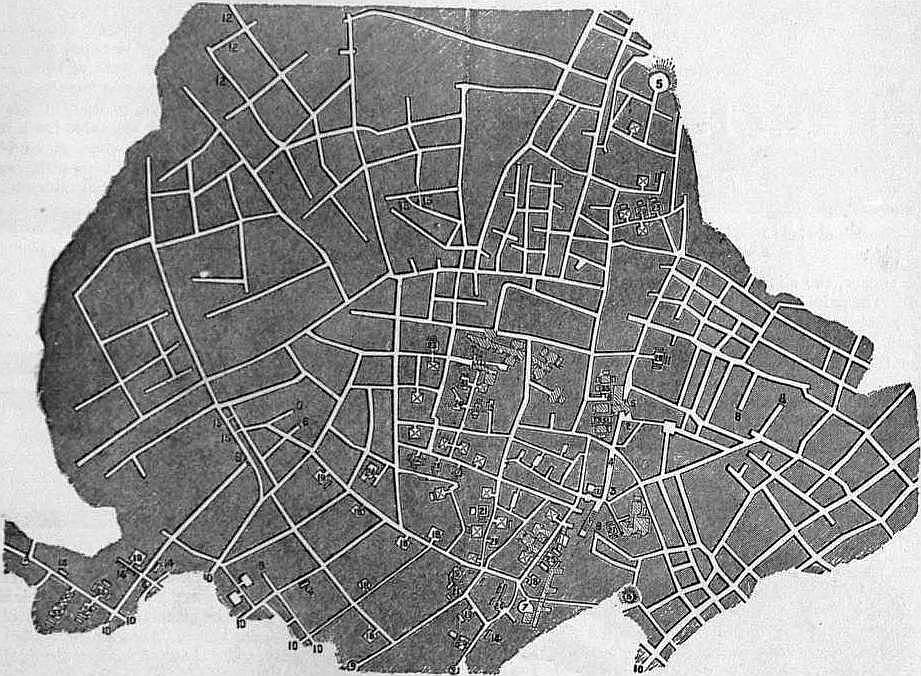 |
||
| Fig. 1.—Plan of part of the Cemetery of Sant’ Agnese. (From Martigny.) | ||
A. Entrance from the Basilica of St Agnes. 1, 2. Ancient staircases leading to the first storey. 3. Corridors from the staircases. 4. Two ruined staircases leading to the lower storey. 5. Steps of the rock. |
6. Air-shafts, or luminaria. 7. Ruined vault. 8. Blind ways. 9. Passages built up or ruined. 10. Passages obstructed by landslips. 11. Unfinished passage. 12. Passages destitute of tombs. |
13. Narrow apertures between adjoining galleries. 14-17. Arcosolia. 18-32. Cubicula. 33. Chapel with vestibule and apse, and two chairs. 34. Double chapel with three chairs. 35. Large chapel in five divisions. |
The graves, or loculi, as they are commonly designated, were, in the Christian cemeteries, with only a few exceptions (Padre Marchi produces some from the cemetery of St Ciriaca, Monum. primitiv. tav. xiv. xliii. xliv.), parallel with the length of the gallery. In the pagan cemeteries, on the other hand, the sepulchral recess as a rule entered the rock like an oven at right angles to the corridor, the body being introduced endways. The plan adopted by the Christians saved labour, economized space, and consulted reverence in the deposition of the corpse. These loculi were usually constructed for a single body only. Some, however, were formed to contain two, three, or four, or even more corpses. Such recesses were known respectively as bisomi, trisomi, quadrisomi, &c., terms which often appear in the sepulchral inscriptions. After the introduction of the body the loculi were closed with the greatest care, either with slabs of marble the whole length of the aperture, or with huge tiles, three being generally employed, cemented together with great exactness so as to prevent the escape of the products of decomposition (fig. 4). Where any epitaph was set up—an immense number are destitute of any inscription at all—it is always painted or engraved on these slabs or tiles. In the earlier interments the epitaph is usually daubed on the slab in red or black paint. In later examples it is incised in the marbles, the letters being rendered clearer by being coloured with vermilion. The enclosing slab very often bears one or more Christian symbols, such as the dove, the anchor, the olive-branch, or the monogram of Christ (figs. 5, 6). The palm branch, which is also of frequent occurrence, is not an indisputable mark of the last resting-place of a martyr, being found in connexion with epitaphs of persons dying natural deaths, or those prepared by persons in their lifetime, as well as in those of little children, and even of pagans. Another frequent concomitant of these catacomb interments, a small glass vessel containing traces of the sediment of a red fluid, embedded in the cement of the loculus (fig. 7), has no better claim. The red matter proves to be the remains of wine, not of blood; and the conclusion of the ablest archaeologists is that the vessels were placed where they are found, after the eucharistic celebration or agape on the day of the funeral or its anniversary, and contained remains of the consecrated elements as a kind of religious charm. Not a few of the slabs, it is discovered, have done double duty, bearing a pagan inscription on one side and a Christian one on the other. These are known as opisthographs. The bodies were interred wrapped in linen cloths, or swathed in bands, and were frequently preserved by embalming. In the case of poorer interments the destruction of the body was, on the contrary, often accelerated by the use of quicklime.
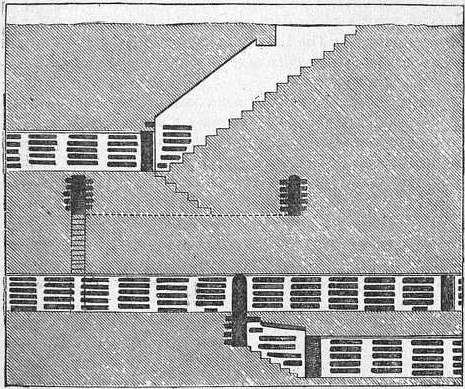 |
| Fig. 2—Section of Galleries at different levels. (From Seroux d’Agincourt.) |
 |
| Fig. 3—View of a Gallery. |
 |
| Fig 4.—Loculi. (From de Rossi.) |
 |
| Figs. 5 and 6.—Loculi. (From de Rossi.) |
Interment in the wall-recess or loculus, though infinitely the most common, was not the only mode employed in the catacombs. Other forms of very frequent recurrence are the table tomb and arched tomb, or arcosolium. From the annexed woodcuts it will be seen that these only differ in the form of the surmounting recess. In each case the arched tomb was formed by an oblong chest, either hollowed out of the rock, or built of masonry, and closed with a horizontal slab. But in the table-tomb (fig. 8) the recess above, essential for the introduction of the corpse, is square, while in the arcosolium (fig. 9), a form of later date, it is semicircular. Sarcophagi are also found in the catacombs, but are of rare occurrence. They chiefly occur in the earlier cemeteries, and the costliness of their construction confined their use to the wealthiest classes—e.g. in the cemetery of St Domitilla, herself a member of the imperial house. Another unfrequent mode of interment was in graves like those of modern times, dug in the floor of the galleries (Marchi, u.s., tav. xxi. xxvi.). Table-tombs and arcosolia are by no means rare in the corridors of the catacombs, but they belong more generally to the cubicula, or family vaults, of which we now proceed to speak.
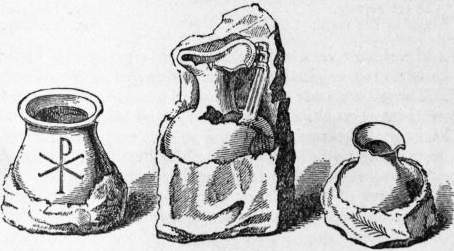 |
| Fig. 7—Glass Bottles. (From Bosio.) |
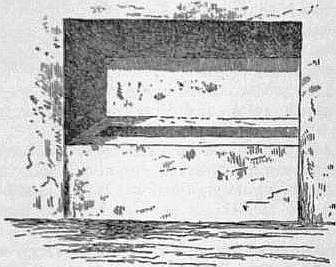 |
| Fig. 8.—Table-tomb. |
These cubicula are small apartments, seldom more than 12 ft. square, usually rectangular, though sometimes circular or polygonal, opening out of the main corridors. They are not unfrequently ranged regularly along the sides of the galleries, the doors of entrance, as may be seen in a previous illustration (fig. 3), following one another in as orderly succession as the bedchamber doors in the passage of a modern house. The roof is sometimes flat, but is more usually vaulted, and sometimes rises into a cupola. Both the roof and the walls are almost universally coated with stucco and covered with fresco paintings—in the earlier works merely decorative, in the later always symbolical or historical. Each side of the cubiculum, except that of the entrance, usually contains a recessed tomb, either a table-tomb or an arcosolium. That facing the entrance was the place of greatest honour, where in many instances the remains of a martyr were deposited, whose tomb, according to primitive usage, served as an altar for the celebration of the eucharist. This was sometimes, as in the Papal crypt of St Calixtus (fig. 10), protected from irreverence by lattice work (transennae) of marble. The cubiculum was originally designed for the reception of a very limited number of dead. But the natural desire to be buried near one’s relatives caused new tombs to be cut in the walls, above and around and behind the original tombs, the walls being thus completely honeycombed with loculi, sometimes as many as seventy, utterly regardless of the paintings originally depicted on the walls. Another motive for multiplying the number of graves operated when the cubiculum contained the remains of any noted saint or martyr. The Christian antiquary has cause continually to lament the destruction of works of art due to this craving. One of the most perfect examples of early Christian pictorial decoration, the so-called “Dispute with the Doctors,” in the catacomb of Calixtus, the “antique style of beauty” of which is noticed by Kugler, has thus suffered irreparable mutilation, the whole of the lower part of the picture having been destroyed by the excavation of a fresh grave-recess (Bottari, vol. ii. tav. 15). The plates of De Rossi, Ferret, and, indeed, all illustrations of the catacombs, exhibit frequent examples of the same destructive superstition. The illustrations (figs. 11 and 12), taken from De Rossi’s great work, representing two of the cubicula in the cemetery of St Calixtus, show the general arrangement of the loculi and the character of the frescoes which ornament the walls and roof. These paintings, it will be seen, are simply decorative, of the same style as the wall-paintings of the baths, and those of Pompeii.
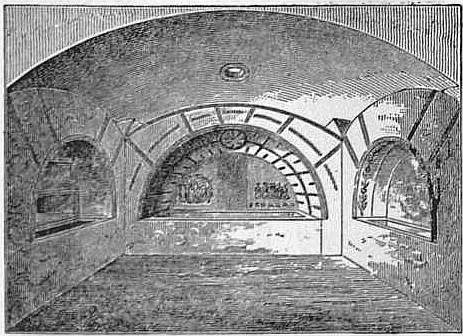 |
| Fig. 9—Arcosolia. (From Bosio.) |
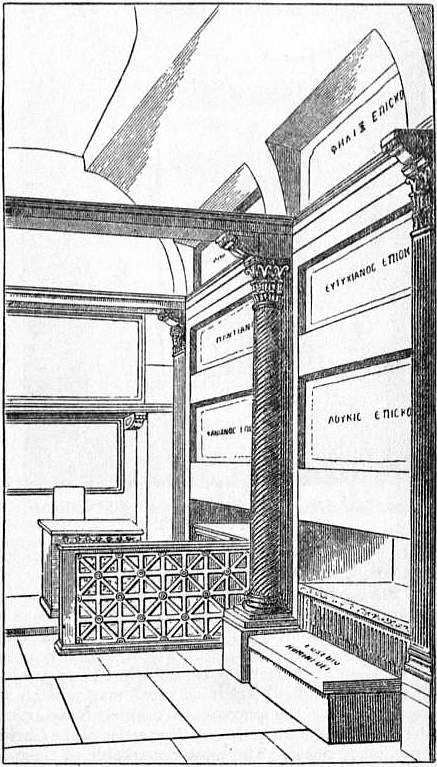 |
| Fig. 10—Restoration of the Papal Crypt, Cemetery of St Calixtus. (From de Rossi.) |
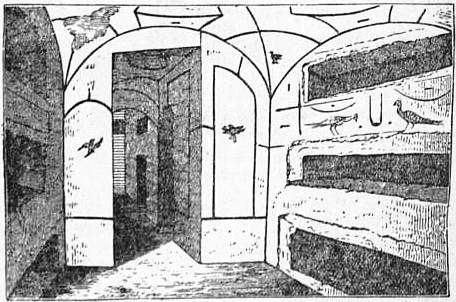 |
| Fig. 11.—Cubiculum in Cemetery of St Calixtus. (From de Rossi.) |
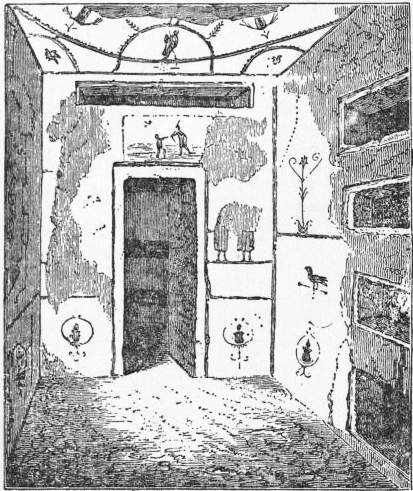 |
| Fig. 12.—Cubiculum in the Cemetery of St Calixtus. (From de Rossi.) |
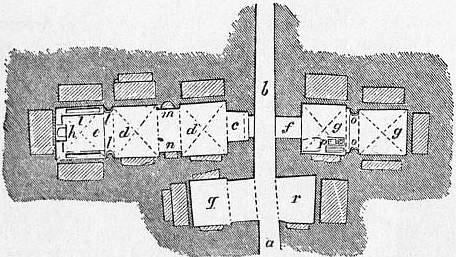 |
| Fig. 13.—Plan of a supposed Church, Catacomb of Sant’ Agnese. (From Marchi.) |
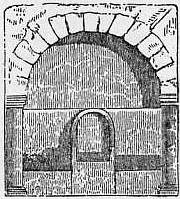 |
| Fig. 14.—Bishop’s Chair. Catacomb of Sant’ Agnese. |
Each cubiculum was usually the burying-place of some one family, all the members of which were interred in it, just as in the chantry-chapels connected with medieval churches. In them was celebrated the funeral-feast on the day of burial and on its anniversary, as well as the eucharist, which was the invariable accompaniment of funerals in the primitive church (Bingham, Orig. Eccl. bk. xxiii. c. iii. 12). The funeral-banquet descended to the Christian church from pagan times, and was too often profaned by heathen licence. St Augustine, in several passages, inveighs against those who thus by “gluttony and insobriety buried themselves over the buried,” and “made themselves drunk in the chapels of the martyrs, placing their excesses to the score of religious reverence for the dead.” (August., De Mor. Eccl. Cathol., c. 34, Contr. Faust, lib. xx. c. 21, Confess., lib vi. c. 2) Some curious frescoes representing these funeral-feasts, found in the cubicula which were the scene of them, are reproduced by Bosio (pp. 355, 391) and others. A romantic air has been thrown over these burial chapels by the notion that they were the places of worship used by the Christians in times of persecution. This to a certain extent is doubtless true, as in the case of the chapel of Santa Priscilla, where the altar or stone coffin of a martyr remains, with a small platform behind it for the priest or bishop to stand upon. But that they can have been so used to any large extent is rendered impossible by their limited dimensions, as none of them could hold more than fifty or sixty persons. In some of the catacombs, however, there are larger halls and connected suites of chapels which may possibly have been constructed for the purpose of congregational worship during the dark periods when the public exercise of the Christian religion was made penal. The most remarkable of these is in the cemetery of Sant’ Agnese (see plan, fig. 13). It consists of five rectangular compartments, three on one side of the corridor and two on the other, connected by a passage intersecting the gallery at right angles. Two of the five compartments are supposed to have been assigned to male, and two to female worshippers, the fifth, at the extremity of the whole, being reserved for the altar and its ministers. In the centre of the end-wall stands a stone chair (fig. 14), considered to have been the episcopal cathedra, with a bench for the clergy on each side. There is no trace of an altar, which may, Marchi thinks, have been portable. The walls of the compartments are occupied by arched sepulchral recesses, above and below which are tiers of ordinary graves or loculi. The arrangements are certainly such as indicate a congregational purpose, but the extreme narrowness of the suite, and still more of the passage which connects the two divisions, must have rendered it difficult for any but a small number to take any intelligent part in the services at the same time. Although the idea of the use of the catacombs for religious worship may have been pressed too far, there can be no doubt that the sacred rites of the church were celebrated within them. We have already spoken of the eucharistic celebrations of which the cubicula were the scene; and still existing baptisteries prove that the other sacrament was also administered there. The most remarkable of these baptisteries is that in the catacomb of San Pontianus (fig. 15). Ten steps lead down to a basin of sufficient depth for immersion, supplied by a spring. Some of the subterranean chambers contain armed seats and benches cut out of the tufa rock. These are supposed by Marchi and others to indicate schoolrooms, where the catechumens were instructed by the bishop or presbyters. But this theory wants verification. It is impossible not to be struck with the remarkable analogy between these rock-hewn chairs and those discovered in the Etruscan tombs, of the purpose of which no satisfactory explanation has been given.
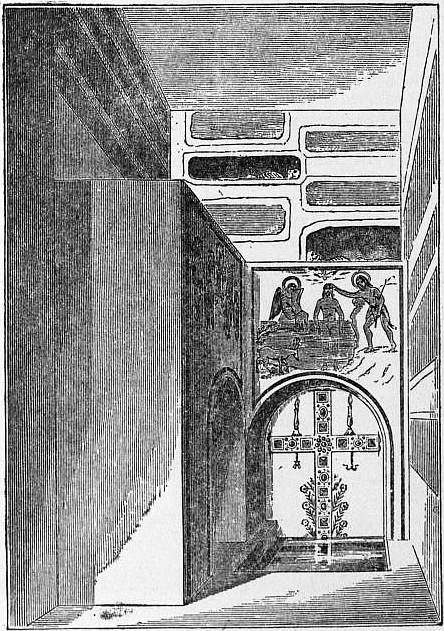 |
| Fig. 15.—Baptistery of San Pontianus. (From Perret.) |
Very exaggerated statements have been made as to the employment of the catacombs as dwelling-places by the Christians in times of persecution. We have, however, sufficient evidence that they were used as places of refuge from Theories of the use of the catacombs. the fury of the heathen, in which the believers—especially the bishops and clergy, who would naturally be the first objects of attack—might secrete themselves until the storm had blown over. This was a purpose for which they were admirably adapted both by the intricacy of their labyrinthine passages, in which any one not possessing the clue would be inevitably lost, and the numerous small chambers and hiding-places at different levels which might be passed unperceived in the dark by the pursuers. As a rule also the catacombs had more than one entrance, and frequently communicated with an arenaria or sand-quarry; so that while one entrance was carefully watched, the pursued might escape in a totally different direction by another. But, to quote J.H. Parker, “the catacombs were never intended, nor fit for, dwelling-places, and the stories of persons living in them for months are probably fabulous. According to modern physicians it is impossible to live many days in the caves of pozzolana in which many of the catacombs are excavated.” Equally exaggerated are the statements as to the linear and lateral extent of the catacombs, and their intercommunication with one another. Without resorting to this exaggeration, Mommsen can speak with perfect truth of the “enormous space occupied by the burial vaults of Christian Rome, not surpassed even by the cloacae or sewers of Republican Rome,” but the data are too vague to warrant any attempt to define their dimensions. Marchi has estimated the united length of the galleries at from 800 to 900 m., and the number of interments at between 6,000,000 and 7,000,000; Martigny’s estimate is 587 m.; and Northcote’s, lower still, at “not less than 350 m.” The idea of general intercommunication is negatived by the fact that the chief cemeteries are separated by low ground or valleys, where any subterranean galleries would be at once filled with water.
It now remains to speak of the history of these subterranean burial-places, together with the reasons for, and mode of, their construction. From the period of the rediscovery of the catacombs in the 16th century till comparatively recent times a gigantic fallacy prevailed, repeated by writer after writer, identifying the Christian burial-places with disused sand-pits. It was accepted as an unquestionable fact by every one who undertook to describe the catacombs, that the Christians of Rome, finding in the labyrinthine mazes of the exhausted arenariae, which abounded in the environs of the city, whence the sand used in building had been extracted, a suitable place for the interment of their martyred brethren, where also the sacred rites accompanying the interment might be celebrated without fear of interruption, took possession of them and used them as cemeteries. It only needed a comparison of the theory with the visible facts to refute it at once, but nearly three centuries elapsed before the independence of the arenariae and the catacombs was established. The discovery of this independence is due to Marchi. Starting with the firmest belief in the old traditional view, his own researches by degrees opened his eyes to the truth, now universally recognized, that the catacombs were exclusively the work of the Christians, and were constructed for the interment of the dead. It is true that a catacomb is often connected with the earlier sand-quarry, and starts from it as a commencement, but the two are excavated in different strata, suitable to their respective purposes, and their plan and construction are so completely unlike as to render any confusion between them impossible.
The igneous formation of which the greater part of the Roman Campagna is, in its superior portion, composed, contains three strata known under the common name of tufa,—the “stony,” “granular,” and “sandy” tufa,—the last being commonly known as pozzolana.3 The pozzolana is the material required for building purposes, for admixture with mortar; and the sandpits are naturally excavated in the stratum which supplies it. The stony tufa (tufa litoide) is quarried as building-stone. The granular tufa is useless for either purpose, containing too much earth to be employed in making mortar, and being far too soft to be used as stone for building. Yet it is in this stratum, and in this alone, that the catacombs are constructed; their engineers avoiding with equal care the solid stone of the tufa litoide and the friable pozzolana, and selecting the stratum of medium hardness, which enabled them to form the vertical walls of their galleries, and to excavate the loculi and cubicula without severe labour and also without fear of their falling in. The annexed illustration (fig. 16) from Marchi’s work, when compared with that of the catacomb of Sant’ Agnese already given, presents to the eye the contrast between the wide winding irregular passages of the sand-pit, calculated for the admission of a horse and cart, and the narrow rectilinear accurately-defined galleries of the catacomb. The distinction between the two is also plainly exhibited when for some local or private reasons an ancient arenaria has been transformed into a cemetery. The modifications required to strengthen the crumbling walls to support the roof and to facilitate the excavation of loculi, involved so much labour that, as a rule, after a few attempts, the idea of utilizing an old quarry for burial purposes was abandoned.
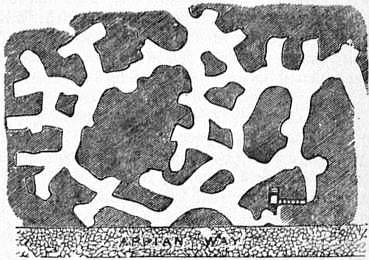 |
| Fig. 16.—Arenaria beneath the Cemetery of Calixtus. |
Another equally erroneous idea was that these vast burial-places of the early Christians remained entirely concealed from the eyes of their pagan neighbours, and were constructed not only without the permission of the municipal authorities but without their cognizance. Nothing can be farther from the truth. Such an idea is justly stigmatized by Mommsen as ridiculous, and reflecting a discredit as unfounded as it is unjust on the imperial police of the capital. That such vast excavations should have been made without attracting attention, and that such an immense number of corpses could have been carried to burial in perfect secrecy is utterly impossible. Nor was there any reason why secrecy should have been desired. The decent burial of the dead was a matter especially provided for by the Roman laws. No particular mode was prescribed. Interment was just as legal as cremation, and had, in fact, been universally practised by the Romans until the later days of the republic.4 The bodies of the Scipios and Nasos were buried in still existing catacombs; and if the Christians preferred to adopt that which Minucius Felix calls “the better, and more ancient custom of inhumation” (Octavius, c. 2), there was absolutely nothing, to quote the words of Northcote (Roma sotterran. pp. 56, 61), “either in their social or religious position to interfere with their freedom of action. The law left them entire liberty,... and the faithful did but use their liberty in the way that suited them best, burying their dead according to a fashion to which many of them had been long accustomed, and which enabled them at the same time to follow in death the example of him who was also their model in life.” Interment in rock-hewn tombs, “as the manner of the Jews is to bury,” had been practised in Rome by the Jewish settlers for a considerable period anterior to the rise of the Christian Church. A Jewish catacomb, now lost, was discovered and described by Bosio (Rom. sott. p. 141), and others are still accessible. They are to be distinguished from Christian catacombs only by the character of their decorations, the absence of Christian symbols and the language of their inscriptions. There would, therefore, be nothing extraordinary in the fact that a community, always identified in the popular heathen mind with the Jewish faith, should adopt the mode of interment belonging to that religion. Nor have we the slightest trace of any official interference with Christian burials, such as would render secrecy necessary or desirable. Their funerals were as much under the protection of the law, which not only invested the tomb itself with a sacred character, but included in its protection the area in which it stood, and the cella memoriae or chapel connected with it, as those of their heathen fellow-citizens, while the same shield would be thrown over the burial-clubs, which, as we learn from Tertullian (Apolog. c. 39), were common among the early Christians, as over those existing among the heathen population of Rome.
We may then completely dismiss the notion of there being any studied secrecy in connexion with the early Christian cemeteries, and proceed to inquire into the mode of their formation. Almost without exception, they had their origin in Mode of formation. small burial areas, the property of private persons or of families, gradually ramifying and receiving additions of one subterranean storey after another as each was required for interments. The first step would be the acquisition of a plot of ground either by gift or purchase for the formation of a tomb, Christians were not beyond the pale of the law, and their faith presented no hindrance to the property being secured to them in perpetuity. To adapt the ground for its purpose as a cemetery, a gallery was run all round the area in the tufa rock at a convenient depth below the surface, reached by staircases at the corners. In the upright walls of these galleries loculi were cut as needed to receive the dead. When these first four galleries were full others were mined on the same level at right angles to them, thus gradually converting the whole area into a net-work of corridors. If a family vault was required, or a burial chapel for a martyr or person of distinction, a small square room was excavated by the side of the gallery and communicating with it. When the original area had been mined in this way as far as was consistent with stability, a second storey of galleries was begun at a lower level, reached by a new staircase. This was succeeded by a third, or a fourth, and sometimes even by a fifth. When adjacent burial areas belonged to members of the same Christian confraternity, or by gift or purchase fell into the same hands, communications were opened between the respective cemeteries, which thus spread laterally, and gradually acquired that enormous extent which, “even when their fabulous dimensions are reduced to their right measure, form an immense work.”5 This could only be executed by a large and powerful Christian community unimpeded by legal enactments or police regulations, “a living witness of its immense development corresponding to the importance of the capital.” But although, as we have said, in ordinary times there was no necessity for secrecy, yet when the peace of the Church was broken by the fierce and often protracted persecutions of the heathen emperors, it became essential to adopt precautions to conceal the entrance to the cemeteries, which became the temporary hiding-places of the Christian fugitives, and to baffle the search of their pursuers. To these stormy periods we may safely assign the alterations which may be traced in the staircases, which are sometimes abruptly cut off, leaving a gap requiring a ladder, and the formation of secret passages communicating with the arenariae, and through them with the open country.
When the storms of persecution ceased and Christianity had become the imperial faith, the evil fruits of prosperity were not slow to appear. Cemetery interment became a regular trade in the hands of the fossores, or grave-diggers, who appear to have established a kind of property in the catacombs, and whose greed of gain led to that destruction of the religious paintings with which the walls were decorated, for the quarrying of fresh loculi, to which we have already alluded. Monumental epitaphs record the purchase of a grave from the fossores, in many cases during the lifetime of the individual, not unfrequently stating the price. A very curious fresco, found in the cemetery of Calixtus, preserved by the engravings of the earlier investigators (Bottari, tom. ii. p. 126, tav. 99), represents a “fossor” with his lamp in his hand and his pick over his shoulder, and his tools lying about him. Above is the inscription, “Diogenes Fossor in Pace depositus.”
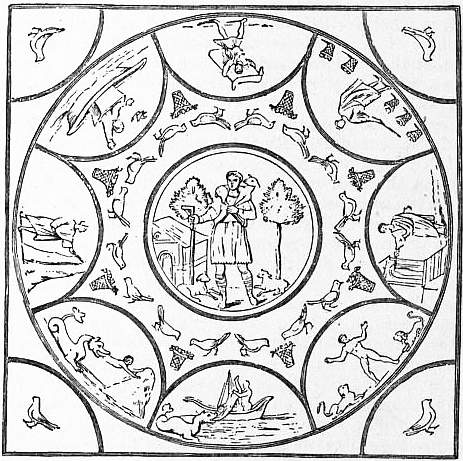 |
|
| Fig. 17.—Fresco Ceiling. (From Bosio.) The subjects, beginning at the top and going to the right, are— |
|
(1) The paralytic carrying his bed. (2) The seven baskets full of fragments. (3) Raising of Lazarus. (4) Daniel in the lions’ den. |
(5) Jonah swallowed by the fish. (6) Jonah vomited forth. (7) Moses striking the rock. (8) Noah and the dove. In the centre, the Good Shepherd. |
It is unnecessary to enter on any detailed description of the frescoes which cover the walls and ceilings of the burial-chapels in the richest abundance. It must suffice to say that the earliest examples are only to be distinguished from the mural decorations employed by their pagan contemporaries (as seen at Pompeii and elsewhere) by the absence of all that was immoral or idolatrous, and that it was only very slowly and timidly that any distinctly Decoration. religious representations were introduced. These were at first purely symbolical, meaningless to any but a Christian eye, such as the Vine, the Good Shepherd, the Sheep, the Fisherman, the Fish, &c. Even the personages of ancient mythology were pressed into the service of early Christian art, and Orpheus, taming the wild beasts with his lyre, symbolized the peaceful sway of Christ; and Ulysses, deaf to the Siren’s song, represented the Believer triumphing over the allurements of sensual pleasure. The person of Christ appeared but rarely, and then commonly simply as the chief personage in an historical picture. The events depicted from the life of Christ are but few, and always conform rigidly to the same traditional type. The most frequent are the miracle at Cana, the multiplication of the loaves and fishes, the paralytic carrying his bed, the healing of the woman with the issue of blood, the raising of Lazarus, Zacchaeus, and the triumphal entry into Jerusalem. The Crucifixion, and subjects from the Passion, are never represented. The cycle of Old Testament subjects is equally limited. The most common are the history of Jonah as a type of the Resurrection, the Fall, Noah receiving the dove with the olive branch, Abraham’s sacrifice of Isaac, Moses taking off his shoes, David with the sling, Daniel in the lions’ den, and the Three Children in the fiery furnace. The mode of representation is always conventional, the treatment of the subject no less than its choice being dictated by an authority to which the artist was compelled to bow. All the more valuable of these paintings have been produced in J.H. Parker’s series of photographs taken in the catacombs by the magnesium light.6 Wilpert’s great work, in which these frescoes are reproduced in colours, now enables the student even better to distinguish the styles of different centuries and follow the course of artistic development or decay.
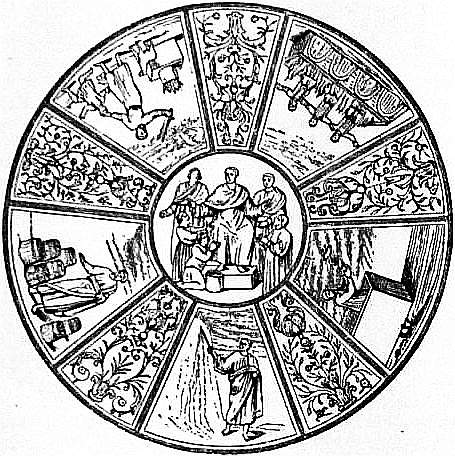 |
|
| Fig. 18.—Fresco Ceiling. (From Bosio.) The subjects, beginning at the bottom and going to the right, are— |
|
(1) Moses striking the rock. (2) Noah and the dove. (3) The three children in the furnace. |
(4) Abraham’s sacrifice. (5) The miracle of the loaves. |
Beyond Rome and its suburbs the most remarkable Christian catacombs are those in the vicinity of Naples, described by Pelliccia (De Christ. Eccl. Polit. vol. iv. Dissert. 5), and in separate treatises by Bellerman and Schultze. Plans of them are also given by Agincourt in his great work on Christian art. These catacombs differ materially from those of Rome. They were certainly originally stone-quarries, and the hardness of the rock Catacombs of Naples. has made the construction practicable of wide, lofty corridors and spacious halls, very unlike the narrow galleries and contracted chambers in the Roman cemeteries. The mode of interment, however, is the same as that practised in Rome, and the loculi and arcosolia differ by little in the two. The walls and ceilings are covered with fresco paintings of different dates, in some cases lying one over the other. This catacomb contains an unquestionable example of a church, divided into a nave and chancel, with a rude stone altar and bishop’s seat behind it.
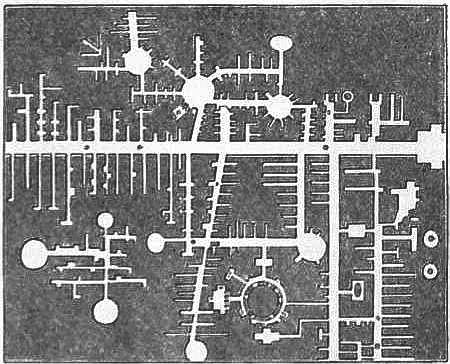 |
| Fig. 19.—Plan of the Catacombs of St John, Syracuse. |
 |
| Fig. 20.—Plan of Circular Hall, Catacombs of St John, Syracuse. (From Agincourt.) |
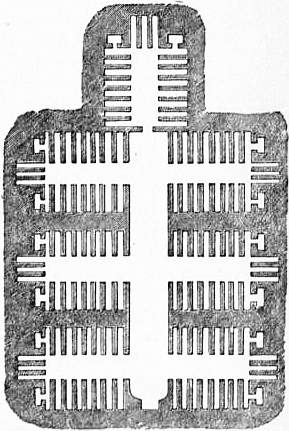 |
| Fig. 21—Plan of Catacomb at Alexandria. (From Agincourt.) |
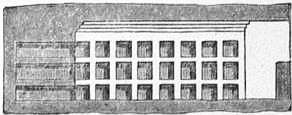 |
| Fig. 22.—Section of a Gallery in Catacomb at Alexandria. (From Agincourt.) |
At Syracuse also there are very extensive catacombs known as “the Grottos of St John.” They are also figured by Agincourt, and described by Denon (Voyage en Sicile et Malte) and Führer. There is an entire underground city with Syracuse. several storeys of larger and smaller streets, squares and cross ways, cut out of the rock; at the intersection of the cross ways are immense circular halls of a bottle shape, like a glass-house furnace, lighted by air shafts. The galleries are generally very narrow, furnished on each side with arched tombs, and communicating with family sepulchral-chambers closed originally by locked doors, the marks of the hinges and staples being still visible. The walls are in many places coated with stucco adorned with frescoes, including palms, doves, labara and other Christian symbols. The ground-plans (figs. 19, 20), from Agincourt, of the catacomb and of one of the circular halls, show how widely this cemetery differs in arrangement from the Roman catacombs. The frequency of blind passages and of circular chambers will be noticed, as well as the very large number of bodies in the cruciform recesses, apparently amounting in one instance to nineteen. Agincourt remarks that this cemetery “gives an idea of a work executed with design and leisure, and with means very different from those at command in producing the catacombs of Rome.”
Denon also describes catacombs at Malta near the ancient capital of the island. The passages were all cut in a close-grained stone, and are very narrow, with arched ceilings, running very irregularly, and ramifying in all directions. Malta. The greater part of the tombs stand on either side of the galleries in square recesses (like the table-tombs of the Roman catacombs), and are rudely fashioned to imitate sarcophagi. The interments are not nearly so numerous as in other catacombs, nor are there any vestiges of painting, sculpture or inscriptions. At Taormina in Sicily is a Saracenic catacomb, also Taormina. figured by Agincourt. The main corridor is 12 ft. wide, having three or more ranges of loculi on either side, running longitudinally into the rock, each originally closed by a stone bearing an inscription.
Passing to Egypt, a small Christian catacomb at Alexandria is described and figured by de Rossi.7 The loculi here also are set endways to the passage. The walls are abundantly decorated with paintings, one of a liturgical character. But the most extensive Egypt. catacombs at Alexandria are those of Egypto-Greek origin, from the largest of which, according to Strabo (lib. xvii. p. 795), the quarter where it is placed had the name of the Necropolis. The plan, it will be seen, is remarkable for its regularity (figs. 21, 22). Here, too, the graves run endways into the rock. Other catacombs in the vicinity of the same city are described by Pocock and other travellers, and are figured by Agincourt.
Subterranean cemeteries of the general character of those described are very frequent in all southern and eastern countries. A vast necropolis in the Sidon. environs of Saida, the ancient Sidon, is described in Renan’s Mission en Phénicie, and figured in Thobois’s plates. It consists of a series of apartments approached by staircases, the sides pierced with sepulchral recesses running lengthwise into the rock.
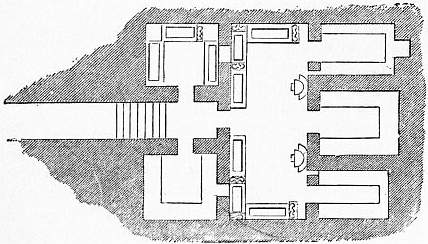 |
| Fig. 23.—Plan of a Tomb at Cervetri. (From Dennis.) |
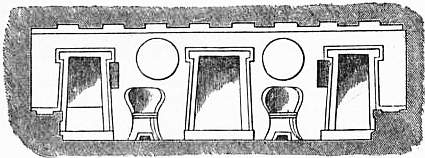 |
| Fig. 24.—Section of the Tomb of the Seats and Shields, Cervetri. (From Dennis.) |
The rock-hewn tombs of Etruria scarcely come under the category of catacombs, in the usual sense, being rather independent family burial-places, grouped together in a necropolis. They are, however, far too remarkable Rocktombs of Etruria. to be altogether passed over. These sepulchres are usually hollowed out of the face of low cliffs on the side of a hill. They often rise tier above tier, and are sometimes all on the same level “facing each other as in streets, and branching off laterally into smaller lanes or alleys”; and occasionally forming “a spacious square or piazza surrounded by tombs instead of houses” (Dennis, Cities and Cemeteries of Etruria, ii. 31). The construction of the tombs commonly keeps up the same analogy between the cities of the living and those of the dead. Their plan is for the most part that of a house, with a door of entrance and passage leading into a central chamber or atrium, with others of smaller size opening from it, each having a stone-hewn bench or triclinium on three of its sides, on which the dead, frequently a pair of corpses side by side, were laid as if at a banquet. These benches are often hewn in the form of couches with pillows at one end, and the legs carved in relief. The ceilings have the representation of beams and rafters cut in the rock. In some instances arm-chairs, carved out of the living rock, stand between the doors of the chambers, and the walls above are decorated with the semblance of suspended shields. The walls are often covered with paintings in a very simple archaic style, in red and black. As a typical example of the Etruscan tombs we give the plan and section (figs. 23, 24) of the Grotta detta Sedia at Cervetri from Dennis (pp. 32, 35). The tombs in some instances form subterranean groups more analogous to the general idea of a catacomb. Of this nature is the very remarkable cemetery at Poggio Gaiella, near Chiusi, the ancient Clusium, of a portion of the principal storey of which the woodcut (fig. 25) is a plan. The most remarkable of these sepulchral chambers is a large circular hall about 25 ft. in diameter, supported by a huge cylindrical pillar hewn from the rock. Opening out of this and the other chambers, and connecting them together, are a series of low winding passages or cuniculi, just large enough for a man to creep through on all fours. No plausible suggestion has been offered as to the purpose of these mysterious burrows, which cannot fail to remind us of the labyrinth which, according to Varro’s description as quoted by Pliny (Hist. Nat. lib. xxxvi. c. 19, § 4), was the distinguishing mark of Porsena’s tomb, and which have led some adventurous archaeologists to identify this sepulchre with that of the great king of Etruria (Dennis, u.s., pp. 393 ff.).
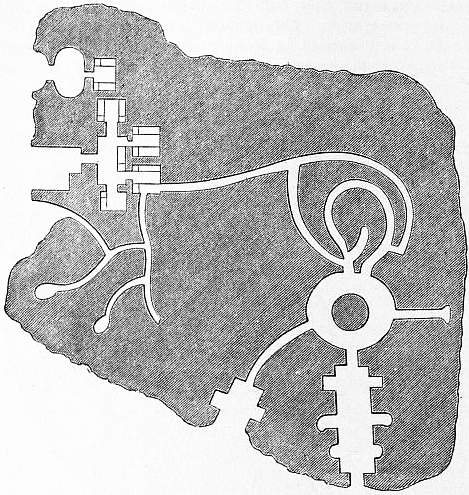 |
| Fig. 25.—Plan of a portion of the principal storey in the Poggio Gajella. (From Dennis.) |
Modern Discoveries.—In 1873 was discovered, near the cemetery of St Domitilla, the semi-subterranean basilica of Santi Nereo ed Achilleo, 100 ft. by 60 ft. This is now covered with a roof, and the fallen columns have been raised up. The lower part of a pillar, which once supported a baldachino over the altar, still preserves the name Acilleus, and beneath it a bas-relief of the martyr, with his hands bound, receiving his death-blow from the executioner. The base of a similar column has only feet in the same attitude, and probably bore the name Nereus. In a grave in the apse was found a large fragment of an inscription, composed by Pope Damasus, but set up by his successor Siricius, which, from the note-book of a Salzburg pilgrim of the 8th century, can be completed thus:—
 |
Militiae nomen dederant saevum Officium pariter spectantes juss Praeceptis pulsante metu servi Mira fides rerum subito posue Conversi fugiunt ducis impia castr Projiciunt clypeos faleras tel Confessi gaudent Christi portar Credite per Damasum possit quid
Nereus (see Rom. xvi. 15) and Achilleus, said to have been baptized by St Peter, refused to do the bidding of Domitian as praetorians, and entering the service of Flavia Domitilla, suffered martyrdom with their mistress Petronilla, of the Aurelian family closely connected with the Flavii, and the spiritual daughter of St Peter, who was buried in a sarcophagus with the inscription:—
avreliae · petronillae · fil · dvlcissimae
This is now in St Peter’s, but was probably originally behind the apse of this basilica, for there is a fresco of her in an arcosolium, with a matron named Veneranda. The original entrance to the cemetery leads directly into a spacious corridor with no loculi, but recesses for sarcophagi, and decorations of the classical style of the 2nd century. From this a wide staircase leads directly down to a chamber, discovered in March 1881, of a very early date. Within an arcosolium is a tablet set up by “Aurelius Ampliatus and his son Gordian, to Aurelia Bonifatia, his incomparable wife, a woman of true chastity, who lived 25 years, 2 months, 4 days, and 2 hours.” The letters are of the 2nd century; but above the arcosolium was found a stone with great letters, 5 or 6 in. high: “AMPLIATI, the tomb of Ampliatus.” Now Ampliatus is a servile name: how comes it to be set up with such distinction in the sepulchre of the Flavii? Romans xvi. 8 supplies the answer: “Salute Ampliatus, most beloved to me in the Lord.” De Rossi thinks the identification well grounded (Bullettino, 1881, p. 74). Epitaphs of members of the Flavian family have been found here, and others stating that they are put up “Ex indulgentia flaviae domitillae vespasiani neptis.” So that De Rossi did not hesitate to complete an inscription on a broken stone thus:—
 |
De Rossi began his excavations in the cemetery of Santa Priscilla in 1851, but for thirty years nothing but what had been described by Bosio came to light. In 1880 he unearthed a portion near the Cappella Greca, and found galleries that had not been touched since they were filled in during the Diocletian persecution. The loculi were intact and the epitaphs still in their places, so that “they form a kind of museum, in which the development, the formulae, and the symbolic figures of Christian epigraphy, from its origin to the end of the 3rd or 4th century, can be notified and contemplated, not in artificial specimens as in the Lateran, but in the genuine and living reality of their original condition.” (Bullett., 1884, p. 68). Many of the names mentioned in St Paul’s Epistles are found here: Phoebe, Prisca, Aquilius, Felix Ampliatus, Epenetus, Olympias, Onesimus, Philemon, Asyncritus, Lucius, Julia, Caius, Timotheus, Tychicus, Crescens, Urbanus, Hermogenes, Tryphaena and Trypho(sa) on the same stone. Petrus, a very rare name in the catacombs, is found here several times, both in Greek and in Latin. The neighbouring Coemeterium Ostrianum was anciently known as “Fons S. Petri,” “ubi Petrus baptizavit,” “ubi Petrus prius sedit.” This cemetery derives its name from Priscilla, mother of Pudens, who is said to have given hospitality to St Peter the Apostle. We are reminded of St Paul, and of his friends Aquila and Prisca, by a monument erected by an imperial freedman who was Praepositvs Tabernacvlorvm—chief tentmaker. In 1888 a corridor was discovered which had at one time been isolated from the rest of the cemetery. It had no loculi, but recesses in the wall to receive sarcophagi. At the end of the corridor there was a large chamber, 23 ft. by 13 ft., once lined with marble and the ceiling covered with mosaic, a few fragments of which still remain. The only tomb here was a sarcophagus, of which the broken front bears the letters which show it to have been the epitaph of one of the Acilian family:—
acilio glabrioni filio
In the vicinity are fragments of the epitaphs of Manius Acilius and Priscilla, of Quintus Acilius and Caia Acilia in Greek, another Greek inscription “Acilius Rufinus mayest thou live in God.” After careful examination of the nine Acilii, who were consuls, De Rossi concludes that this was the resting-place of that Acilius Glabrio, consul with Trajan, a.d. 91, who in the year of his consulate was compelled by Domitian to fight with beasts in the arena, and then banished and put to death in 95. The question of his Christianity seems settled by the discovery of the sepulchre of these Christian Acilii. From this crypt a staircase led up to the basilica in which Pope Silvester was buried, and the whole plan of which was laid bare by De Rossi. The tomb of St Silvester could be identified, and that of Pope Siricius “at his feet,” as the pilgrim noted (Bullett., 1890, pp. 106-119).
Just before De Rossi’s death, Mgr. Wilpert discovered in the Cappella Greca a painting of the “Fractio Panis” or eucharistic feast, which he cleansed from the dust with which it had been covered. The picture of the Blessed Virgin and Child, which De Rossi ascribed to the 2nd, if not to the 1st century, has received an unexpected proof of its antiquity. In 1890 the floor of the gallery in which it stands was excavated, and another floor was found to be 6 ft. below its supposed level. The loculi in this lower portion were intact, with inscriptions of the 2nd century still in their places, proving that the niche in which that picture was painted must have been considerably older than the lowering of the floor. A flight of iron steps enables the visitor now to examine this venerable specimen of early Christian art.
After the death of De Rossi, one of his pupils, H. Stevenson, since dead, discovered in 1896 a small subterranean basilica in the catacomb of Santi Pietro e Marcellino on the Via Labicana, with pious acclamations on the plaster similar to those in the Papal crypt in St Calixtus. Near the well-known subterranean chapel in the Coemeterium Ostrianum was discovered by Mgr. Crostarosa, in 1877, another chapel, in which Signor Armellini found traces of St Emerentiana, foster-sister of St Agnes. Near this a whole region of galleries has been brought to light with loculi intact.
Explorations conducted in the cemetery of Domitilla in 1897-1898 brought to light a fine double crypt with frescoes representing Christ seated between six male and female saints; also an inscription relating to a new saint (Eulalius) in a cubiculum of the 3rd century. In 1899-1900 were discovered two opposite cubicula in the catacomb of Santi Pietro e Marcellino. These were unknown to Bosio, and are both covered with frescoes, the vault being in one case decorated with the scene which represents Christ seated among the apostles and pronouncing sentence upon the defunct. An inscription discovered in 1900 on the site of the ancient cemetery of St Ciriaca, and dating from a.d. 405, states that one Euryalus bought a site ad mensam beati martyris Laurentii from a certain fossor whose name has been erased. This is interesting as an example of what was known as memoriae damnatio or the blotting out of a name on account of some dishonourable action. From the end of the 4th to the first half of the 5th century, the fossores had the privilege of selling sites, which frequently led to grave abuses. In 1901-1902 excavations in the cemetery of Santa Priscilla, near the Cappella Greca, revealed a polygonal chamber. This may have originally been the nymphaeum of the great villa of the Acilii Glabriones, the hypogaeum of which was discovered by De Rossi near this spot in 1888. It may have been used as a burial-place for martyrs, and Professor Marucchi is inclined to see in it the sepulchral chapel of Pope Marcellinus, who died in a.d. 304 during the persecutions of Diocletian. In 1902, in that part of the Via Ardeatina which passes between the cemeteries of Calixtus and Domitilla, was discovered a crypt with frescoes and the sanctuary of a martyr: it is thought that this, rather than a neighbouring crypt brought to light in 1897, may prove to be the sepulchral crypt of SS. Marcus and Marcellianus. In a cubiculum leading out of a gallery in the vicinity there was also discovered an interesting impression in plaster of an inscription of the mother of Pope Damasus, beginning:
hic damasi mater posvit lavren[tia membra].
In the same year building operations in the Via di Sant’ Onofrio revealed the presence of catacombs beneath the foundations: examination of the loculi showed that no martyrs or illustrious persons were buried here.
In 1903 a new cemetery with frescoes came to light on the Via Latina, considered by Marucchi to have belonged to a heretical sect. In the same year the Jewish cemetery on the Via Portuense, known to Bosio but since forgotten, was rediscovered. The subterranean basilica of SS. Felix and Adauctus, discovered by Boldetti and afterwards choked up with ruins, was cleared again: the crypt, begun by Damasus and enlarged by Siricius, contains frescoes of the 6th-7th centuries.
A good plan of the catacombs at Albano (at the 15th milestone of the Appian way), discovered by Boldetti and described by De Rossi, has been published by Marucchi (Nuovo Bulletino di archeologia cristiana, 1902, pp. 89 ff.). In 1904 a small subterranean cemetery was discovered at Anagnia. Catacombs have also been recently discovered on the site of Hadrumetum near Sousse in Tunisia.
Authorities.—The classical work on the catacombs of Rome is G.B. De Rossi’s Roma sotterranea, on which most of the accounts in other languages than Italian have been based. The fine volume by Mgr. Wilpert, Le Pitture delle catacombe romane (Rome, 1903), in which all the important frescoes are reproduced in colours, is to be regarded as an addition to the Roma sotterranea. All new discoveries made by the active Commissione di archeologia sacra are chronicled with as little delay as possible in the Nuovo Bulletino de archeologia cristiana published in Rome.
The most recent accounts of the catacombs are to be found in the following books:—Armellini, Gli Antichi Cimiteri cristiani di Roma e d’ Italia (Rome, 1893); O. Marucchi, Le Catacombe romane (Rome, 1903; also translated into French), Manuale di epigrafia cristiana (Milan, 1904); M. Besnier, Les Catacombes de Rome (Paris, 1909).
Among the older works are: Bosio, Roma sotterranea, Severano’s edition (1632), and Aringhi’s edition (1651); Boldetti, Osservazioni sopra i cimiteri dei santi martiri (Rome, 1720); Bottari, Sculture e pitture sagre, &c. (Rome, 1737-1754); Seroux d’Agincourt, Histoire de l’art par les monuments (Paris, 1823; German ed., 1840); G. Marchi, Monumenti delle arti cristiane primitive (Rome, 1844); Raoul Rochette, Tableau des catacombes de Rome (2nd ed., Paris, 1853); Perret, Les Catacombes de Rome (Paris, 1855)—a sumptuous folio work, but not always accurate, Roller, Les Catacombes de Rome (Paris, 1881); V. Schultze, Die Katakomben (Leipzig, 1882).
Works written in English are: Northcote and Brownlow, Roma sotterranea (London, 1869; based upon De Rossi); Wharton Marriott, The Testimony of the Catacombs (London, 1870); J.H. Parker, The Archaeology of Rome: the Catacombs; Smith and Cheetham, Dictionary of Christian Antiquities, s.v. “Catacombs”; R. Lanciani, Pagan and Christian Rome (London, 1892); W. Lowry, Christian Art and Archaeology, ch. ii. (London, 1901; a useful introduction to the subject); H. Gee, “The Church in the Catacombs,” in W. Lefroy’s Lectures in Ecclesiastical History (1896); Th. Mommsen, in the Contemporary Review, May 1871.
Accounts of the catacombs will also be found in the encyclopaedias and manuals published under the following names: Martigny, Pératé, F.X. Kraus (Realencyklopädie and Geschichte der christlichen Kunst), Reusens, V. Schultze and C.M. Kauffmann, and in the large new Dictionnaire d’archéologie chrétienne et liturgie, published at Paris under the editorship of Dom F. Cabrol.
The catacombs at Naples are described in C.F. Bellermann, Über die ältesten christlichen Begräbnisstätten und besonders die Katakomben zu Neapel (Hamburg, 1839); Armellini, as above, and V. Schultze, Die Katakomben von San Gennaro dei Poveri in Neapel (Jena, 1877).
For the catacombs in Malta, A.A. Caruana, Ancient Pagan Tombs and Christian Cemeteries in the Islands of Malta (Malta, 1898), and A. Mayr, “Die altchristlichen Begräbnisstätten auf Malta,” in Römische Quartalschrift, vol. xv. pp. 216 and 352 (Rome, 1901), may be consulted.
The fullest account of the Sicilian catacombs is given by J. Führer, Forschungen zur Sicilia sotterranea (Munich, 1897); and D.C. Barrecca, Le Catacombe di San Giovanni in Siracusa (Syracuse, 1906).
A catacomb of the 5th century, discovered at Kertch in South Russia, is described by J. Kulakovsky in Materials for Russian Archaeology (St Petersburg, 1896; a publication of the Russian Imperial Archaeological Commission), but it is written in Russian, as also is the account by V. Latyshev, in Vizantieski Vremennik, vol. vi. pp. 337 ff. (St Petersburg, 1899).
The catacombs at Hadrumetum (Sousse) are described by A.F. Leynard, Les Catacombes d’Hadrumète, deuxième campagne de fouilles (1904-1905). See also Revue Tunisienne (1905), p. 250.
For the catacombs of Alexandria, Neroutsos Bey, L’Ancienne Alexandrie, may be consulted in addition to De Rossi’s article mentioned in the text.
1 The most important of these lists are the two Itineraries belonging to the first half of the 7th century, in the Salzburg library. One still earlier, but less complete, appears in the Notitia Urbis Romae, under the title Index Coemeteriorum. Another Itinerary, preserved at Einsiedeln, printed by Mabillon, dates from the latter half of the same century. That found in the works of William of Malmesbury (Hardy’s ed. vol. ii. pp. 539-544) appears to be copied from it, or both may be from the same source. De Rossi gives a comparative table of these Itineraries and other similar lists.
2 Hieron., Comment. in Ezech. lib xx. c. 40. The translation is Dean Burgon’s.
3 In Rome the three strata are known to geologists as tufa litoide, tufa granolare and pozzolana.
4 Cicero is our authority for the burial of Marius, and for Sulla’s being the first member of the Gens Cornelia whose dead body was burnt (De Legg. ii. 22).
5 Mommsen’s chosen example of an ancient burial-chamber, extending itself into a catacomb, or gathering subterranean additions round it till a catacomb was established, is that of the cemetery of St Domitilla, traditionally identified with a granddaughter of Vespasian, and the catacomb of Santi Nereo ed Achilleo on the Appian and Ardeatine way.
6 Parker’s invaluable series of Roman photographs may be seen at the library of the Victoria and Albert museum, at the Ashmolean museum and the Bodleian library, Oxford.
7 Bulletino di archaeologia cristiana, November 1864, August 1865. See also Authorities, below.


 W. R. B.; O. M. D.)
W. R. B.; O. M. D.)
